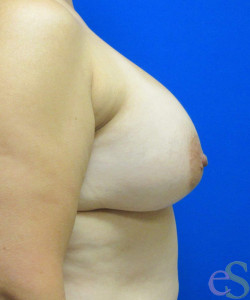Breast implants can be a great choice for women to boost their self-confidence. But sometimes, your personal preferences or health considerations change. Whether you’ve become unhappy with your implants or feel that they no longer fit your lifestyle, you always have the option to remove them.
Dr. Eric S. Schaffer has been helping patients feel their best for over 30 years. Board-certified by the American Board of Plastic Surgery and with training from top institutions like Harvard and Yale, Dr. Schaffer is a true expert in breast procedures and can remove your implants.

Why Remove Breast Implants?
There are many reasons someone might want to remove their breast implants. Some common ones include:
- Changes in size, like feeling that your breasts are now too large due to weight gain
- No longer wanting larger breasts
- Worrying about the need for future surgeries as you get older
- Health concerns or medical conditions
- Feeling like you’re “done” with having implants
Sometimes, issues with the implants themselves may cause the need for removal, such as:
- Hardened Capsule: Older implants can have capsules which harden over time. Hardened capsules can make future breast exams more difficult. If you have textured implants, it may be recommended that you also take out the capsule to reduce the risk of a rare cancer known as ALCL.
- Breast Implant Illness: The capsule is removed because the patient isn’t feeling well and is concerned that the implants might be contributing to their symptoms. The capsule will be sent to a lab for further testing to rule out infection or other issues.
What Happens During a Breast Implant Removal Procedure?
Breast implant removal is a simple procedure that usually takes one to three hours. We’ll give you general anesthesia, so you’ll be asleep and won’t feel anything.
The procedure typically goes as follows:
- Dr. Schaffer makes small incisions, usually in the same spots as your original breast surgery.
- He will remove the implant only or he will remove the implant and capsule as decided in your consultation.
- If you’ve chosen to get new implants, either saline or silicone can be used.
- Finally, when he is satisfied with the result, he will close the incisions with dissolvable sutures.
- Next up – recovery!
Breast Implant Removal Before & After Photos
Before

After

Before

After

Breast Implant Removal Recovery

You may need to curtail your normal activities for a week or two after breast implant removal. Post-operative aftercare may be very similar to your first breast surgery.
Our guidelines will include instructions for incision care and activity restrictions that limit you to walking and other light tasks. We’ll likely advise you to avoid lifting objects that weigh more than a few pounds.
If you’re feeling up to it, you should be able to return to work about a week after your breast implant removal. However, you’ll need to take it easy with more intense activities and follow Dr. Schaffer’s advice. Full recovery usually takes about six to eight weeks.
Breast Implant Removal vs. Replacement
When deciding between removing or replacing your implants, it really comes down to your goals. Replacing them is a good choice if you still like the look of your implants but are concerned about their age or other possible complications.
However, if you no longer want implants or are dealing with health concerns, removal may be the better option. We can restore a more natural look and eliminate the need for future surgeries. Dr. Schaffer will guide you through both options to find what’s best for you.
Breast Appearance After Implant Removal
Some women are concerned with how their breasts will look after removing the implants. Without the implants, your breasts may appear smaller and could experience some sagging, especially if the implants were large or you’ve had them for many years. The elasticity of your skin and how much natural breast tissue you have will also influence the final appearance.
You could choose to get a breast lift during implant removal to help you maintain a youthful shape.
Why Choose Eric S. Schaffer, MD, FACS?
Dr. Eric S. Schaffer brings over 30 years of experience to every patient he sees in the office. He trained at top institutions like Harvard and Yale, is board-certified by the American Board of Plastic Surgery, and is a Fellow of the American College of Surgeons. Throughout his career, Dr. Schaffer has helped countless patients reach their goals while making them feel comfortable and understood. His expertise in breast and body procedures has earned him recognition as one of the best plastic surgeons in the Southwest.
Patients often choose Dr. Schaffer because of his ability to listen closely and give thoughtful guidance. He works with you to develop a plan that feels right, whether it’s breast implant removal or another procedure.
Frequently Asked Questions
No. Like breast augmentation, this procedure is performed using general anesthesia.
When you wake up after surgery, you may feel very similar to how you felt after your initial breast procedure: sore, tender, and groggy. Your surgical wrappings will help support your breasts as the incisions and tissue heal. You may need to take prescription medication for a few days to help manage discomfort.
Scarring is inevitable anytime we make an incision. Your breast implant removal should not incur new scars, though, as the doctor usually uses your original scars as a guide for the surgical incisions.
For several weeks after surgery, your scars may look red or pink and slightly puffy or raised. The skin may look puckered as new collagen forms to repair the tissue. As your new incisions heal, you can consider scar treatments to support tissue regeneration. We can discuss your options at your final post-op visit once we’ve confirmed your incisions are completely closed.
You can expect to have somewhat strict activity restrictions for a week to 10 days after breast implant removal. After that time, you will be able to gradually resume activities, beginning with the lightest, like returning to work or driving.
Strenuous activity, running, and heavy lifting will continue to be restricted for up to six to eight weeks. Our primary objective is for you to have a smooth recovery and long-lasting cosmetic results.
Breast implant removal carries some risks, but it is considered to be a safe procedure. Possible risks include:
- Infection
- Bleeding
- Changes in breast shape or size
- Scarring, especially if a capsulectomy is performed
- Anesthesia-related complications
Dr. Schaffer will walk you through all the potential risks during your consultation and do everything he can to minimize them.
Some women choose to remove their implants after 10 to 15 years due to aging or the potential need for future surgeries. Others may have them taken out earlier if they’re having complications like capsular contracture, or if they just don’t want them anymore.
A consultation with Dr. Schaffer can help you weigh your options to help you decide when to schedule your removal.
Breast implant illness (BII) is a term some women use to describe symptoms they believe are linked to their breast implants. BII is not officially recognized as a medical diagnosis, but many women report symptoms such as:
- Fatigue
- Joint and muscle pain
- Brain fog or difficulty concentrating
- Skin rashes or other skin conditions
- Hair loss
- Anxiety or depression
If you’re experiencing any of these symptoms and believe your implants may be the cause, Dr. Schaffer can evaluate your situation.
Book Your Consultation for Breast Implant Removal
Dr. Eric Schaffer will be happy to discuss your situation with you and help you decide a course of action that best suits your needs. Call 210-227-3223 to set up your informative consultation with Dr. Schaffer.